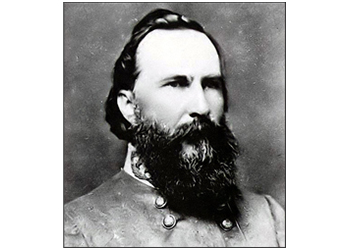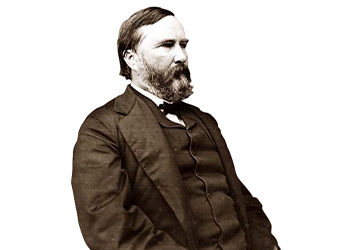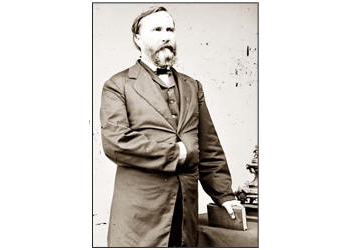General James Longstreet, CSA
James Longstreet was born January 8, 1821 in Edgefield District, South Carolina, the son of planter James and Mary Ann Dent Longstreet. Longstreet spent his early years in Augusta Georgia. On the death of his father, he went with his mother to Somerville, Alabama where he lived with his uncle.
Longstreet entered West Point from Alabama, graduated in 1842, fifty-fourth in a class of sixty-two. He was assigned to various military posts in Missouri and Louisiana until the outbreak of the War with Mexico in 1848. He served under General Zachary Taylor and saw combat at Monterry, Palo Atlo, Resaca and was wounded at Chapultepec.
Major Longstreet felt his loyalty belonged to his native state when the War between the States began. He resigned from the U.S. Army on June 1, 1861 and offered his services to the new Confederacy.
Two weeks after his resignation, the former army major was a new brigadier general in command of a brigade of Virginia and North Carolina troops which he led at The Battle of First Manassas, also called The Battle of Bull Run.
A promotion soon followed and Major General Longstreet was assigned to command a division and then a wing of the Confederate army in Virginia. When General Robert E. Lee took command of the army that he renamed the Army of Northern Virginia, General Longstreet was in command of a corps, which he led through the Seven Days Campaign. General Longstreet, or “Old Pete” as he was nicknamed, proved to be an efficient soldier with a keen eye for battlefield tactics. He learned from his experiences on the battlefield and stubbornly applied his trade in every battle to come. General Lee fondly called him, “my old war horse.”
In the summer of 1862, Lee moved his army northward toward an encounter with Union troops near Manassas, Virginia. The Second Battle of Bull Run was fought near the same area where Confederate forces had driven the Union troops from the field a year before. This two-day struggle pitted the bulk of the Union forces under General John Pope against the corps of General “Stonewall” Jackson. At the height of the battle, Longstreet moved his corps next to Jackson’s position and charged in a vicious counterattack that first turned the Union flank and then swept General Pope’s hapless Union soldiers from the field. The brilliant victory gave Lee the chance to invade Maryland and hopefully cause the people in that state to flock to the Confederate cause. Longstreet’s troops crossed the Potomac and marched toward Frederick while the Union Army, back under the full command of George McClellan, finally reached Maryland and drove directly toward Lee’s then scattered forces. Longstreet’s men fought the Battle of South Mountain and again at the Battle of Antietam, where the general was conspicuous on the field. Longstreet credited his troops with holding the thin southern line against the final Union attacks despite being outnumbered and out gunned by Union artillery. His corps was allowed to rest and reorganize briefly before they marched toward Fredericksburg, Virginia in response to the next Union threat. It was the Battle of Fredericksburg on December 13, 1862 where General Longstreet excelled in his use of a defensive position. His troops held high ground west of the city and easily repulsed repeated Union charges.
By 1863, Longstreet had been promoted to lieutenant general and was one of Lee’s most trusted generals. Though he missed the Battle of Chancellorsville because of military events in southeast Virginia, Longstreet returned to the army in time for the Gettysburg Campaign. With the death of “Stonewall” Jackson after Chancellorsville, General Lee had divided his army into three corps and relied heavily on Longstreet’s opinions.
The general performed well until the battle of Gettysburg began and critics later accused the general of losing the battle by questioning orders and stubborn delays in beginning attacks Lee ordered. He opposed attacking at Gettysburg in favor of maneuvering Meade out of his position. Longstreet, who had come to believe in the strategic offense and the tactical defense, was proven right when the Confederate attacks on the second and third days were repulsed. He proved to be as stubborn with his fellow officers as he was with the enemy and paid little attention to the criticisms until after the close of the Civil War, when he steadfastly defended his opinion that flaws in leadership during the campaign had to be shared with other officers, including the untouchable Lee. This opinion would make General Longstreet controversial until the end of his life.
That September, General Longstreet was ordered to take his corps to Georgia to assist the Confederate army there under Braxton Bragg. He arrived too late to participate in the first day of the battle as the armies, often hand-to-hand, fought desperately all day. The next day, September 20, Bragg again tried to drive between the Union force and Chattanooga, but failed to dislodge Rosecrans’ line. Then, a gap opened in the Federal ranks, and General Longstreet’s Confederates smashed through the hole, routing Rosecrans and half his army. General George H. Thomas took command of the remaining Federals and formed a new battle line on Snodgrass Hill. His men held their ground against repeated assaults, earning Thomas the nickname “Rock of Chickamauga.” After dark, Thomas withdrew his men from the field and retread back to Chattanooga. Bragg did not continue the attack on the Federal army, but against the advise of Longstreet and Bragg’s command staff, he ordered a siege of Chattanooga. In the dispute over the follow-up of the victory, Longstreet was critical of Bragg and was soon detached to Knoxville to drive General Burnside from the city and back into Kentucky.
Arriving at Knoxville, General Longstreet ordered a siege of the city, as fate would have it, the action he opposed at Chattanooga. The plan failed at Knoxville as it did at Chickamauga. General Grant sent reinforcements to both cities, which resulted in Confederate defeats at both cities. Learning that Federal reinforcements were in route to Knoxville, Longstreet ordered an attack on Fort Sanders on November 29, resulting in a Confederate defeat.
Longstreet abandoned the Siege of Knoxville on December 4, and retreated to rejoin General Robert E. Lee and the Army of Northern Virginia. The Federal army pursued, but not too closely. December 14, General Longstreet was at Rogersville, some 60 miles from Knoxville. The Federal army was at Bean Station. Longstreet turned his army around and they clashed at Bean Station. By nightfall, the Federals were retiring from Bean Station back toward Knoxville and the battle ended. The weather turned severe, record low temperatures and snow and the Confederate army was unable to travel and went into winter camp at Russellville. During the winter, the armies fought in the Battle of Mossy Creek (present Jefferson City), Dandridge and Fair Garden.
General Longstreet’s 1863 winter headquarters was in the Nenney family home in Russellville, just outside Morristown, Tennessee.
Friends of General Longstreet Headquarters Museum have renovated the historic home and developed it into a Civil War museum and interpretative center. Photographs and information of the Longstreet Headquarters, and description of the Battles of Fort Sanders, Bean Station, Mossy Creek and Fair Garden are included on this website.
Longstreet’s corps did not return to Virginia until the following May, when Longstreet led them into another battle in an area west of Fredericksburg called the Wilderness. The general was seriously wounded in that battle and the injury kept him away from the army until April 1865. He rejoined the Army of Northern Virginia just in time to witness the abandonment of Richmond and retreat to Appomattox Court House. Longstreet’s command held part of the final Confederate line at Appomattox until a flag of truce stopped the fighting. General Longstreet surrendered and was paroled with his troops.
General James Longstreet made three mistakes that have denied him his deserved place in Southern Posterity.
1. He argued with General Robert E. Lee at Gettysburg
2. He was right
3. He became a Republican.
After the war, Longstreet moved to New Orleans where he became president of an insurance company and owned a cotton business. He then surprised many of his friends when he joined the Republican Party; a choice that horrified many southerners who were ardent democrats saw the Republicans as the political party responsible for the war and reconstruction. Some went so far as to brand him a traitor to the southern cause. Despite the slander and accusations, Longstreet actively participated in southern reunions and became friends with many former enemies including General U.S. Grant whose wife, Julia Dent, was a cousin. In 1880, then ex-President Grant used his influence to have Longstreet appointed as U.S. minister to Turkey. Longstreet moved to Gainesville, Georgia and became US Marshall for the District of Georgia and later a commissioner for the Pacific Railroad under Presidents McKinley and Roosevelt from 1897 to 1904. In his spare time, he wrote articles for popular magazines and eventually published his highly regarded memoirs, From Manassas to Appomattox in 1896. He outlived most of his high-ranking postwar detractors. He died at Gainesville, Georgia on January 2, 1904, the last of the high command of the Confederacy. He is buried in Gainesville.
General Kershaw
Born in Camden, South Carolina in 1822, Joseph Brevard Kershaw enjoyed a growing law practice in Camden before he volunteered to serve with South Carolina troops during the War with Mexico...
Bethesda Church
Bethesda Church, a quaint old building with high-backed pews and an enclosed pulpit, was organized in 1832 by Dr. John McCampbell and members of Hopewell Presbyterian Church near Dandridge...





